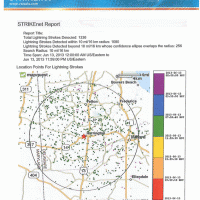Property damage claims to sensitive electronic equipment due to a direct or nearby lightning strike are frequently difficult to substantiate to a high degree of confidence. Electrical damage to common consumer electronic equipment (televisions, computers and accessories, wireless routers, telephones, fax machines, electronic security systems, etc.) is most frequently not visible to the naked eye during a physical inspection of the allegedly failed equipment. So, how do we investigate an electrical loss when an insured claims he has $30,000 worth of non-functioning equipment?
If the date of loss is known, one good method is to use readily available historical weather data to attempt to confirm the passage of a lightning storm through the area of loss. One website, Weather Underground, provides historical data for free, although the precision of the search area is limited to a city or a zip code area. But, sometimes this is enough if the storm was large enough to cover the majority of the search area and only approximate data is adequate. Graphed and tabulated data for wind speed, wind direction, barometric pressure, overall conditions and more are all available at no cost to the user.
Although the presence of lightning is not specifically called out, its presence can often be concluded with a high degree of certainty if other parameters, favorable for lightning, are also present. For example, if there is a sudden increase in the wind speed, coupled with a sudden temperature drop and the presence of rain is noted, it is probable that a thunderstorm was passing through the area at that time. An example of this service is shown below.

A view of a weather report and graph produced for a specific date and time.
Courtesy of Weather Underground.
As can be seen from the graphs above, an abrupt weather change occurred at approximately 10:30 am. The temperature dropped, the wind speed increased significantly and included gusts of approximately 45 mph, and the wind direction abruptly shifted to the northwest. Due to these abrupt changes that were all consistent with local weather during a thunderstorm, it is likely there was a thunderstorm in the area.
If more detailed information is needed on possible lightning activity, a much more powerful tool is the Vaisala STRIKEnet report. For a nominal pay-per-use fee, a detailed report using data from Vaisala’s National Lightning Detection Network® will be prepared and e-mailed to you as a .pdf file in a matter of moments after your internet request.

The STRIKEnet report above displays a map of the lightning search area, which is a circle, typically 10 miles in radius, centered on the loss location. Points shown within the circle indicate the location of a cloud-to-ground lightning strike. Courtesy of Vaisla Inc., STRIKEnet.

Each strike is tabulated by time and by distance from the loss location, as shown above. Courtesy of Vaisla Inc., STRIKEnet.
It is noted that the Weather Underground method and the STRIKEnet method described above analyze the same loss location during the same time period. Indeed, the two sets of results correlate very well because they characterize the same thunderstorm. The STRIKEnet report also clearly shows that the subject thunderstorm was very large, and resulted in more than 1,000 cloud-to-ground strikes within the 10-mile search radius.
In conclusion, the two investigative methods described above provide an array of weather data that can be very helpful to the investigator. Frequently, both methods are used together to characterize a possible thunderstorm as completely as possible. This will help the investigator draw conclusion(s) about the cause of the electrical equipment breakdown with a high degree of confidence.
Founded in 1997, The Warren Group, forensic engineers and consultants provides technical investigations and analysis of personal injury and property claims as well as expert testimony for insurance adjusters and attorneys. Extremely well versed in the disciplines of mechanical, electrical, chemical, structural, accident reconstruction and fire and explosion investigation, our engineers and consultants are known for delivering the truth — origin, cause, responsibility and cost of an event or claim — with unmistakable clarity.




